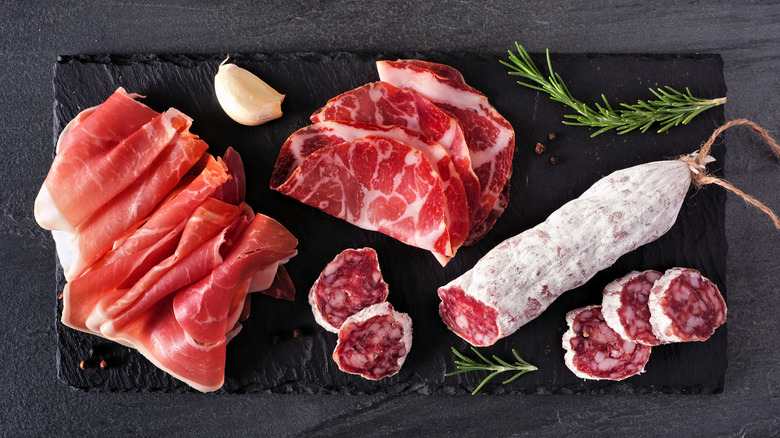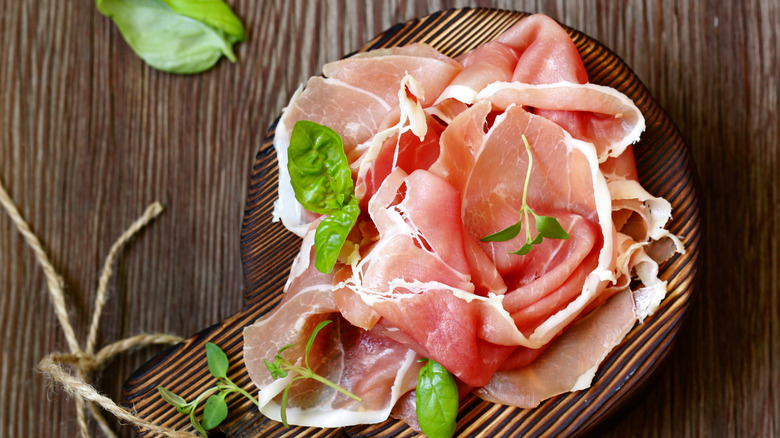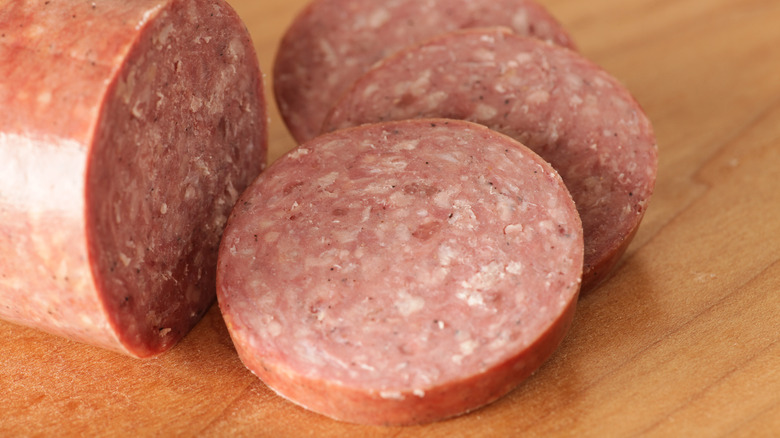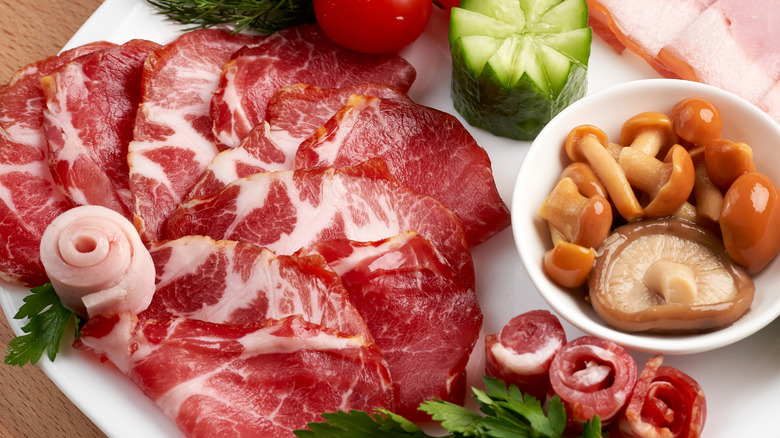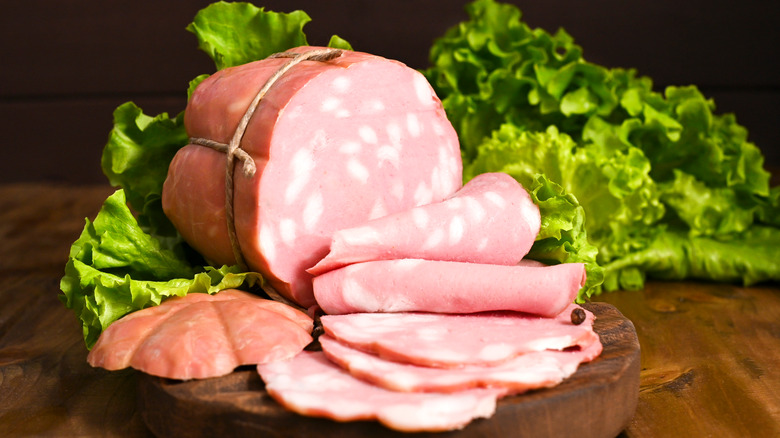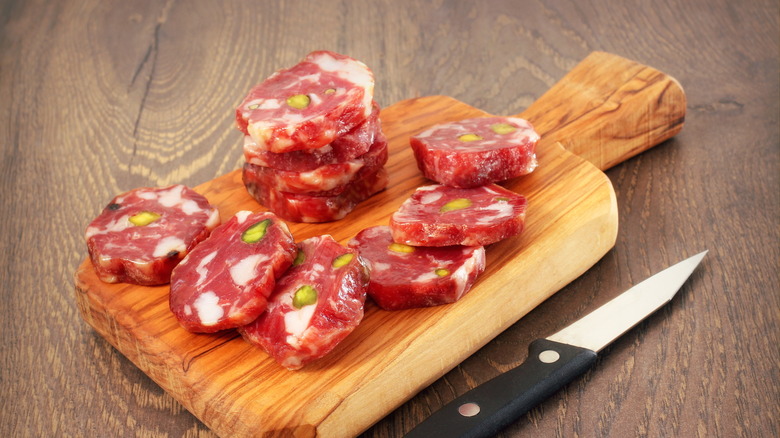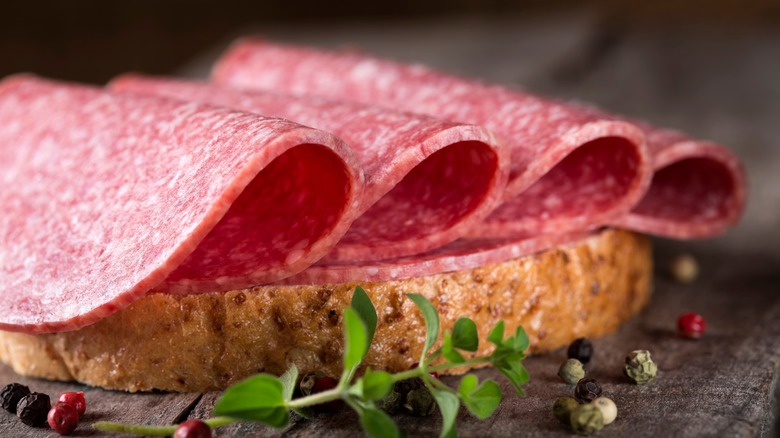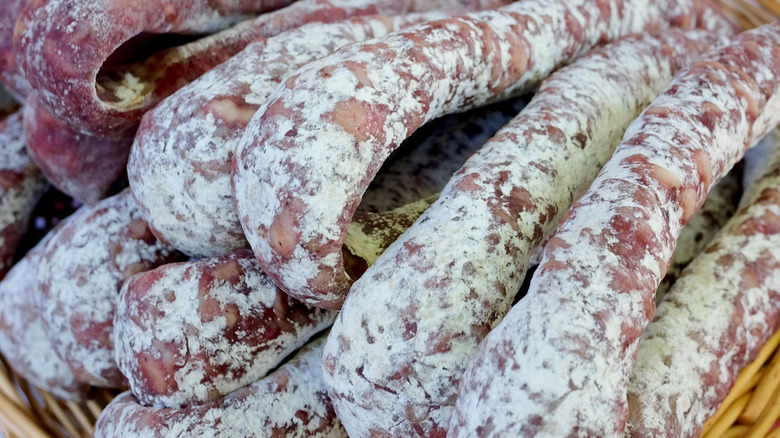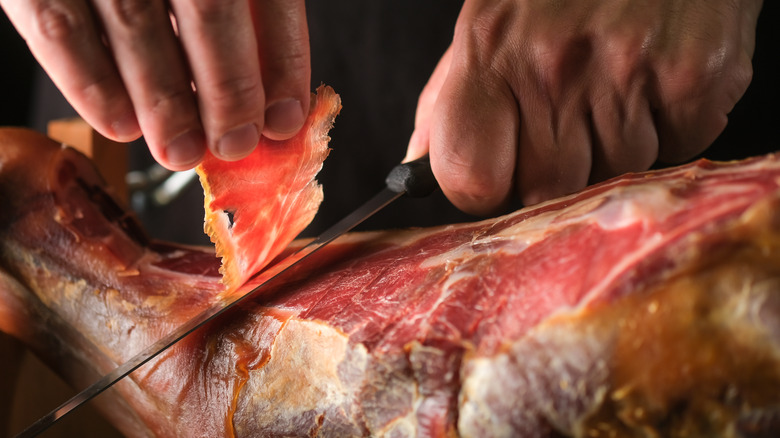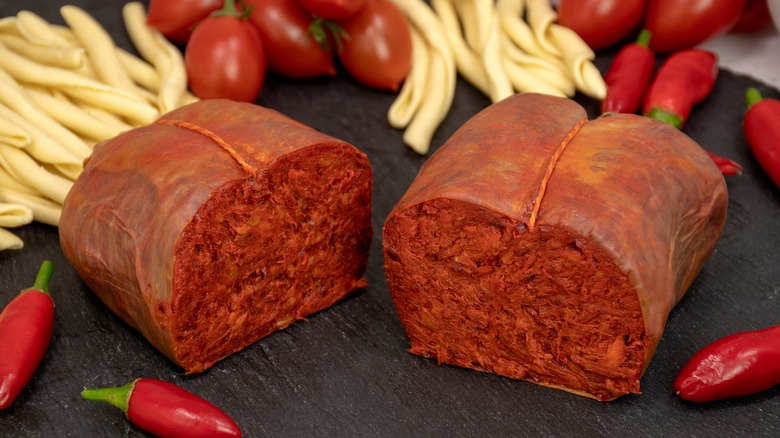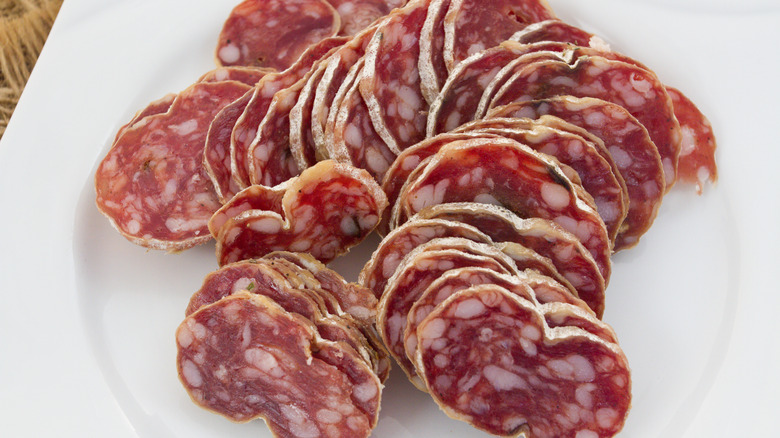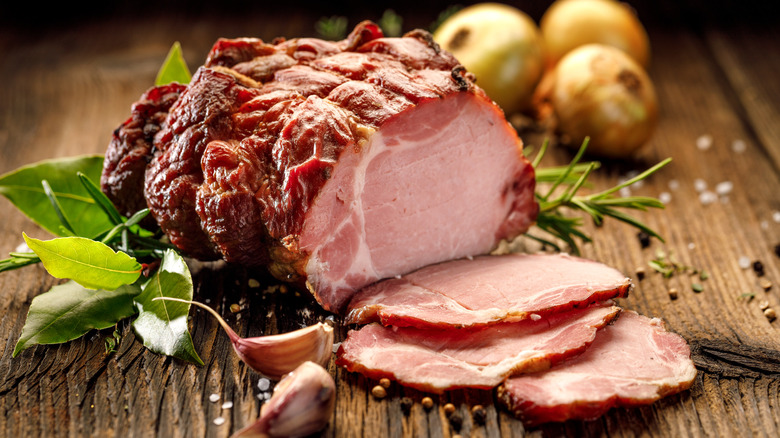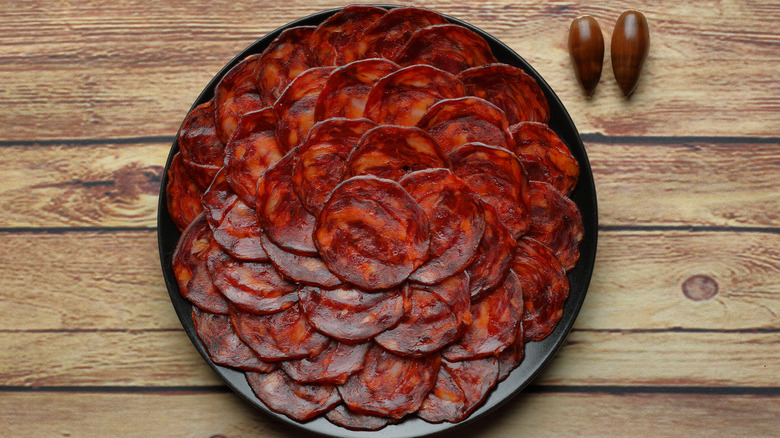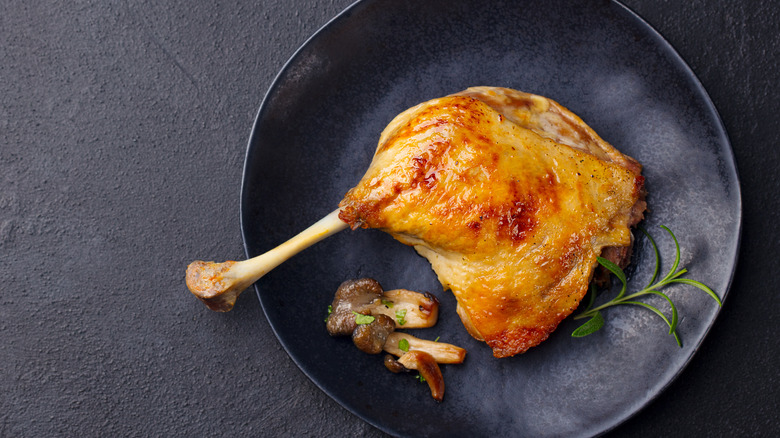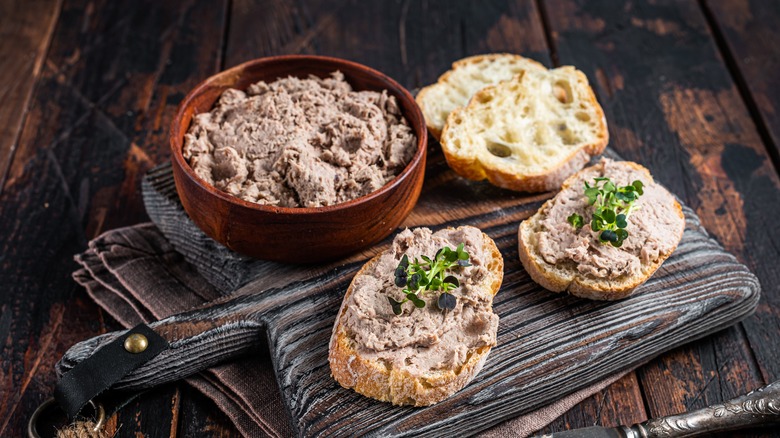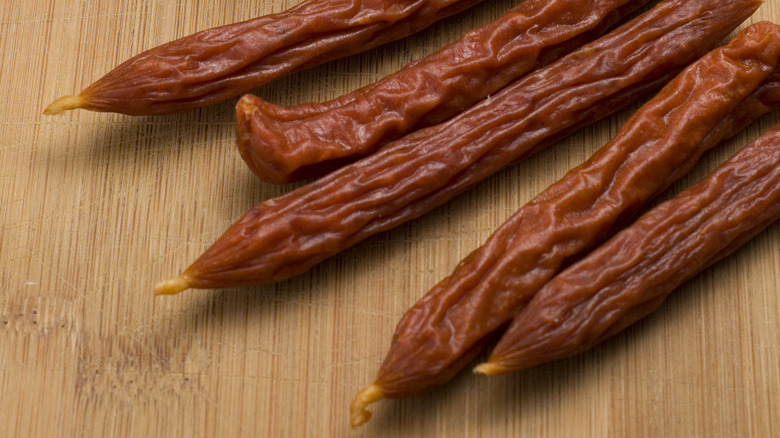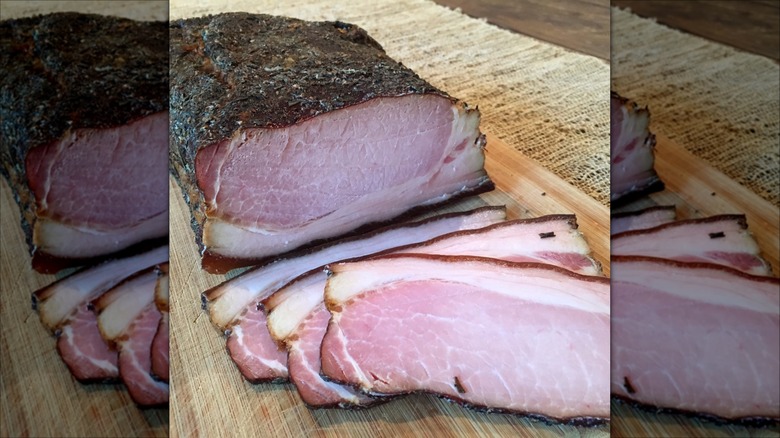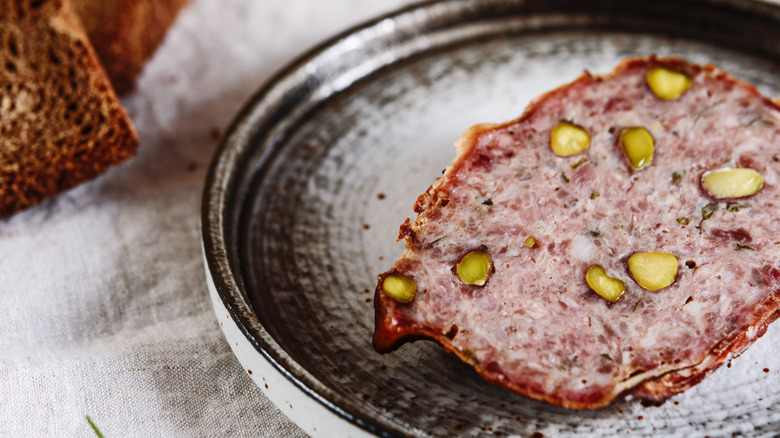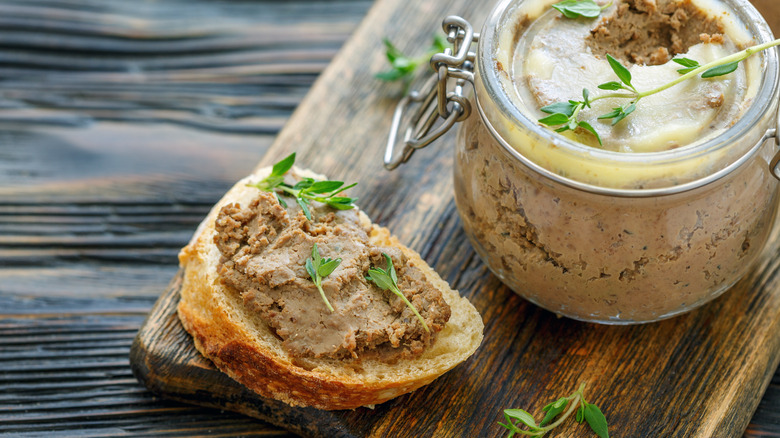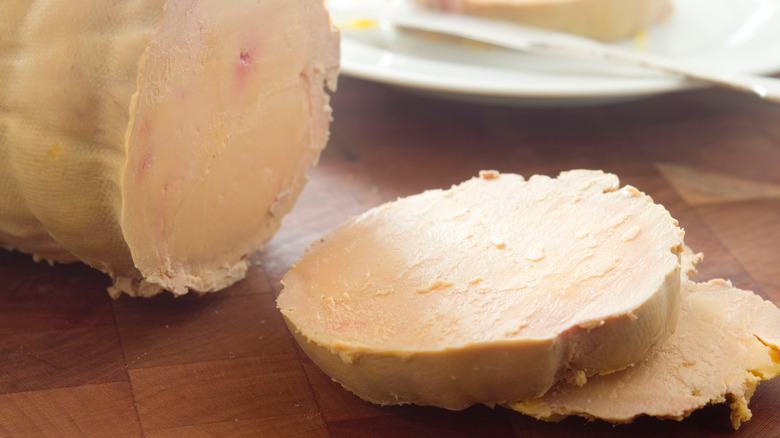The Best Way To Slice Every Type Of Meat
When it comes to charcuterie boards, we all know that the meats are the stars of the show. A thoughtfully assembled charcuterie board typically includes a variety of cured and smoked meats, as well as pâtés, cheese, fruit, and bread.
Preparation is key, whether we're talking charcuterie or other ways to enjoy the products of a butcher's shop. If those meats aren't sliced properly, you won't be able to enjoy them as much as you should. Each type of meat requires a different slicing technique in order to maximize flavor and texture. Meat that contains a lot of spices or is very fatty, for example, should be sliced thin so the flavors don't overwhelm. Conversely, cuts with a more delicate flavor can be served in thicker slices. Other types of meat are soft and work best when spread on bread or a cracker. Here's the best way to slice almost every type of meat.
Prosciutto
Prosciutto is a cured ham made by salting and air-drying the meat, which gives it a unique salty, sweet, and nutty flavor (via BBC Good Food). The texture of prosciutto is smooth and buttery. When slicing prosciutto, use a very sharp knife to get thin, even slices. When slicing prosciutto, you should start by cutting off one end of the ham. Then, hold the ham in one hand and use the other to slowly slice down the length of the meat. Look for paper-thin slices that are almost see-through, allowing you to enjoy this distinctly-flavored meat without overwhelming your palate.
Prosciutto pairs well with a variety of other foods, making it a versatile addition to any charcuterie board. Some of our favorite pairings include melon, figs, grapes, and Parmesan cheese. Supermarket Italy recommends a few condiments and cheese, including truffle honey, fig jam, and burrata cheese.
Summer sausage
Summer sausage dates back to pre-refrigeration Europe, so named because people could enjoy it in the summer due to its curing process (via Hempler's). This type of meat is seasoned with a variety of different spices, which give it a unique flavor that is slightly sweet and spicy. According to VeryMeaty, you can use a food processor to slice your sausage, although it may be hard to get the beautifully even slices you'd want for a charcuterie board. Your best bet is to use a sharp knife on a sausage that has been chilled or frozen so that it won't tear when slicing.
The ideal thickness of summer sausage is up to you, but because of its robust flavor, keep your slices no bigger than ½ inch. Summer sausage is tasty on its own, but pairs particularly well with crackers, mustard, and cheese. It also works well in cooked pasta dishes.
Capicola
Capicola is a cured ham that has a slightly sweet, smoky flavor and pairs well with other meats, cheeses, and fruits. Also called coppa or capocollo, capicola has a variety of seasonings like wine, fennel, and red pepper to give it flavor, as per MasterClass. Compared to the relatively buttery prosciutto, capicola is less fatty and more tender.
Capicola is also served thinly sliced for charcuterie boards (via Robust Kitchen). The best way to slice it is to use a deli slicing machine, but if you do not have one of these, you can also use a very sharp chef's knife. When slicing capicola, be sure to cut against the grain. This will help to prevent the slices from becoming overly tough, as is the case with most meats, according to Well Seasoned. When serving, capicola plays well with a variety of other meats, cheese, and crackers, making it a charcuterie superstar.
Mortadella
Mortadella is a type of Italian cold cut made from ground pork and seasoned with spices, including black pepper. It also often contains pieces of fat (via Cooked Best). Sometimes pistachios or olives are also added. The texture of mortadella can vary from quite smooth to slightly coarse. It has a sweet, rich flavor that pairs well with other salty or savory foods.
According to MasterClass, there are three different types of mortadella: mortadella bologna, mortadella di Campotosto, and mortadella di Prato. Mortadella bologna is the most common, while the other two varieties contain more flavors from spices and wine. Mortadella is usually served cubed or sliced. When cubing mortadella, aim for small, ½-inch cubes that are easy to pick up with a toothpick. When slicing this meat, you'll want relatively thin slices as this is typically a large sausage, but keep the slices thick enough that you can enjoy the texture.
Pork roll
A pork roll is made from pork and a mixture of spices before being cured in sugar, smoked, and then formed into a log. The log is then sliced and served in a variety of ways. The most popular is as a sandwich paired with egg and cheese and beloved in New Jersey (via Eater). You can find it at groceries in the Northeast, but you may have a harder time tracking it down elsewhere.
Pork roll slices need to be cooked before serving. Make slices about as thin as Canadian bacon, using four to six cuts around the slice to keep it from curling as it cooks. It is traditionally served on a hard roll or bagel as part of a breakfast sandwich, but you can also use an English muffin or croissant. While you're at it, you may want to sample this meat on its own in individual slices.
Etna salami
Etna salami gets its flavor from pistachios and lemon zest, while it gets its name from Mount Etna in Sicily. Sicily is known for its citrus fruit and pistachios, according to Visit Sicily, so their inclusion in this salami is a nod to crops of the region. This gives the salami a bright, unique flavor that you won't find in many other cuts of meat, as well as an interesting texture that's present in every bite (via Gourmet Food World).
Etna salami is dense and hard, so it should be sliced thinly to get pieces that are relatively easy to chew and enjoy. This meat is ideal for adding to sandwiches or combining with other meats, nuts, fruit, and cheeses. Gourmet Food World recommends pairing Etna salami with fresh goat cheese to compliment the meat's lemon flavors, a variety of nuts to go with the pistachios, or a floral honey.
Cotto salami
Cotto salami is cooked instead of cured like many other salamis. Cotto is softer than cured salami and is linked to the Piedmont region of Italy, according to Gourmet Food World. Its flavor is robust but perfectly balanced, thanks to a coarse grind and generous seasonings, which can include whole black peppercorns, chili flakes, garlic, cinnamon, and nutmeg.
This salami should be sliced thin and makes a wonderful addition to any charcuterie board. It should be sliced while it's cold and firm but allow it to reach room temperature before serving. Cotto salami is often sold in slices at the grocery store (as are the majority of salamis) and has the same distinctive marbled appearance as pepperoni and other kinds of deli meat (via Art of Grill). Ideal pairings include olives, sweet red peppers, and provolone. Cotto salami also makes a fabulous addition to pizza in place of the traditional pepperoni pie.
Arles salami
Saucisson D'Arles, or Arles salami, is a French style of salami that combines pork and sea salt without any other seasonings, according to Olympia Provisions. This is a timeless sort of meat that goes well with almost anything because of its clean, mild flavor and tender texture. When preparing this meat, be sure to slice the salami on the bias so that each piece is about the thickness of a quarter. You can slice it thicker if you prefer, but keeping things small will allow you to fully enjoy the flavor without overwhelming your palate.
Because the pure flavor of Arles salami is meant to be appreciated on its own, you don't usually want to pair it with any cheeses or fruits with particularly intense flavors. As Gourmet Food World points out, the best way to appreciate this French salami is to enjoy it with a French wine.
Jamón Ibérico
Jamón Ibérico originates from Spain and is made from the hind leg of Iberian pigs that are fed a diet of acorns and grass and live a truly luxurious lifestyle (via Jamon.com). In the fall and winter, the Iberian pigs are released to roam and eat the acorns that have fallen from trees in the fields, a practice that fattens them up and helps create the flavor of Jamón Ibérico. After the pigs are slaughtered, the ham is dry-cured for several months, resulting in a unique flavor that is salty, sweet, and slightly nutty. The meat is dark red, well-marbled, and simply exquisite.
Jamón Ibérico should be sliced very thin to help you appreciate its rich flavors without being overwhelmed. For the best results, use a jamón knife, which is flexible, light, and extremely sharp, to properly prepare this meat.
'Nduja
'Nduja is created with pig fat, herbs, and spices, as well as hot Calabrian peppers, which give this meat its heat and unique red color, as per Serious Eats. This meat was likely created by necessity when poor farmers were left with nothing but the leftovers of expensive cuts of meat sold to the wealthy. Adding spices and letting the meat ferment helped to create the product we still crave today.
Because it is spreadable, 'nduja should be served with a knife and can be enjoyed on bread or crackers. It also tastes great when it's paired with shellfish and can even be stirred into pasta dishes for a punch of flavor (via Bloomberg). Although the taste is intense if you're new to it, 'ndjua compliments a variety of other meats and cheeses. It is on the spicy side, so adding it to more mild flavors will be ideal for people who aren't fans of spicy food.
Rosette de Lyon
When you eat Rosette de Lyon, you'll immediately notice its rustic aroma and sharp spice. According to Taste France, the coarsely chopped meat has hints of garlic that tickle the palate without overpowering it with sweet. After it's stuffed into a natural casing, the sausage is placed in net fabric and then dried. Rosette de Lyon takes longer than other sausages to mature, from six weeks for smaller varieties to four months for the larger ones.
This salami gets its name from its distinctive slightly pink color, which comes from both the casing and curing process. Taste Atlas recommends slicing this salami and serving it with a baguette, as well as cheeses like Grana Padano or Taleggio. As for wines to sip alongside this meat, Côteaux du Lyonnais PDO red or rosé, Côtes du Rhône PDO rosé or red, or a Ventoux PDO rosé will do nicely.
Sweetheart ham
This tasty little ham gets its name because it offers just enough meat to share with your sweetheart. But it's not just the name that's sweet. Sweetheart ham is a sirloin tip ham taken from the top of the leg and placed in a brine made from fresh herbs, garlic, and onion for at least 10 days (via Olympia Provisions). These boneless hams are then smoked over applewood chips for around 10 hours.
According to Gourmet Food World, this process allows the inside of the ham to remain juicy and soft while the outside develops a rich brown crust full of flavor. You can serve sweetheart ham like other ham steaks, meaning it makes an excellent addition to a breakfast plate of eggs, pancakes, waffles, and fruit. The ham can also be thinly sliced and put on a sandwich, or cubed if you really want it to be part of your charcuterie board.
Chorizo Andalucia
Chorizo Andalucia is a type of Spanish sausage made with pork, paprika, garlic, and other spices. It is typically bright red and has a distinct flavor that's slightly sweet and smoky, according to Olympia Provisions. Chorizo Andalucia is typically sold in links or rounds, and can be either fresh or cured. There are many different types of Spanish chorizo out there, ranging from a soft sausage (similar to Mexican chorizo) to firm, cured varieties like Andalucia chorizo (via MasterClass).
When slicing Chorizo Andalucia, cut slices that are about a quarter-inch thick. This will allow you to savor the flavors without being overpowered by the experience. This meat is often found in Spanish tapas dishes and is welcome on any charcuterie board, according to My Kitchen in Spain. Serve it with bread, olives, and cheese. Like most cured meats, it also pairs well with a glass of red wine.
Duck confit
Duck confit is made with duck legs that have been slow-cooked in their own fat. This French dish has a rich, savory flavor and is melt-in-your-mouth tender, according to FoodsGuy. To prepare duck confit, start by seasoning duck legs with salt and pepper. Then, place them in a baking dish and cover them with duck fat. Bake the duck legs in a slow oven for several hours until very tender.
The duck legs are typically stored in their own fat until ready to serve, when they need to be crisped up in a pan or in the oven. Duck confit can be served many different ways. If you want it to be part of a charcuterie board, shred the meat and use it to make finger sandwiches. According to D'Artagnan, duck confit also works well in salads, pies, or paired with potatoes and vegetables for a classic dish.
Duck rillette
Rillettes are a type of pâté originating from the Loire Valley in France. They are made by slowly cooking meat until very tender. The meat is then shredded or chopped and mixed with its own fat, resulting in a spreadable paste (via Wine4Food). Duck rillette is typically spread on bread or crackers as an appetizer.
Duck rillette has a savory, fatty flavor like pork pâté. It pairs well with acidic dishes and condiments such as pickles, mustard, and horseradish. To prepare duck rillette, start off by cooking the duck meat in fat until it is very tender (via Forcemeat Academy). Remove the meat from the fat and shred or chop it into small pieces. Season the duck with salt, pepper, and other spices as desired. Duck rillette can be served cold or at room temperature.
Pepperettes
Pepperettes are smoked meat sticks that are ready to eat. The name comes from Schneiders, which trademarked Pepperettes as a tasty on-the-go meat snack. Today, "pepperettes" also refers to any small, snackable salami with a mild enough flavor to be enjoyed on its own. You can find these products at many grocery stores, delis, and butcher shops. Pepperettes are typically made from smoked pork and contain different spices for distinguished flavors (via Olympia Provisions).
While many pepperette varieties have a similar flavor profile as that of pepperoni, they are less fatty and more dense, according to Impulsive Traveler Guy. The texture is also firmer, which can make these easier to eat as a snack. Pepperettes are often eaten cold or at room temperature. You can enjoy pepperettes as part of a charcuterie board with other cured meats, cheeses, and pickled vegetables. They also pair well with crackers, baguettes, or pretzels.
Landrauchschinken
Landrauchschinken is a traditional Swiss smoked ham. This classic country dish is first aged for 18 days in sea salt, followed by a caramel coating, a generous dose of juniper and rosemary seasoning, and finally a round of applewood smoking. This meat's wonderful combination of sweet herbs and caramelized sugar, together with its buttery and smokey flavor, makes it practically melt in your mouth when you finally get to eat it.
According to Olympia Provisions, landrauchschinken should be thinly sliced like prosciutto. This will allow you to fully savor the flavor without being overwhelmed from all the spices and fatty tastes. If you buy the entire ham, don't forget to remove the skin first. Because it is a Swiss ham, this meat should pair well with a Swiss cheese like Comte or Gruyere. It's also fantastic with some soft bread such as brioche or a baguette.
Pork pistachio pâté
Pork pistachio pâté is a type of pâté made from, you guessed it, pork and pistachios. It has a smooth, creamy texture and a rich, nutty flavor. You'll get subtle crunch from the pistachios and herbaceous flavor from red wine, fresh thyme, and shallot. This pâté goes well with crusty bread, jam, and a bottle of red wine to bring out its nuance.
When purchasing pork pistachio pâté, look for a product made with quality ingredients and with good balance of fat and protein. To serve, simply place slices on crackers, bread, or vegetables. While it may be tempting to spread this soft meat, Olympia Provisions recommends against it. Keeping the texture as-is will help you appreciate everything pork pistachio pâté has to offer. Be sure to store it in the refrigerator but serve this unique pâté at room temperature.
Pork liver mousse
Pork liver mousse is meant to be spread. It's a French dish made of pork liver and fat, eggs, cream, and aromatics like shallots, garlic, and wine (via Taste). The mixture is puréed, then chilled so it will be firm enough to spread. When made properly, it's light and airy, with a delicate liver flavor that's offset by the other ingredients. Still, it may not be the dish for you if you can't stand the taste of liver.
Pork liver mousse is delicious on its own or when spread on a baguette with a dash of stone ground mustard, as per Olympia Provisions. It's also great on bread when topped with olive oil, salt, and freshly ground black pepper. It can be served on a charcuterie board with other meats, cheeses, fruits, and nuts, and it pairs well with other mousses, pâtés, and rillettes.
Foie gras torchon
Foie gras is made from the liver of a duck or goose that has been specially fattened. Torchon is a preparation method where the foie gras is wrapped in a towel while molded (via D'Artagnan). It is typically salt-cured, then poached in water. The result is a smooth, rich pâté.
Foie gras torchon has a rich, buttery flavor that pairs well with either sweet or savory dishes. It can be served as an appetizer or main course and makes an impressive addition to just about any dinner party. The creamy, fatty flavor of foie gras torchon is best complemented by a slice of crusty bread, toasted brioche, or even fruit-enriched breads, such as a cranberry walnut loaf, as suggested by Center of the Plate. It also goes quite nicely with fruit compotes or chutneys. And of course, a great glass of wine is always welcome.
